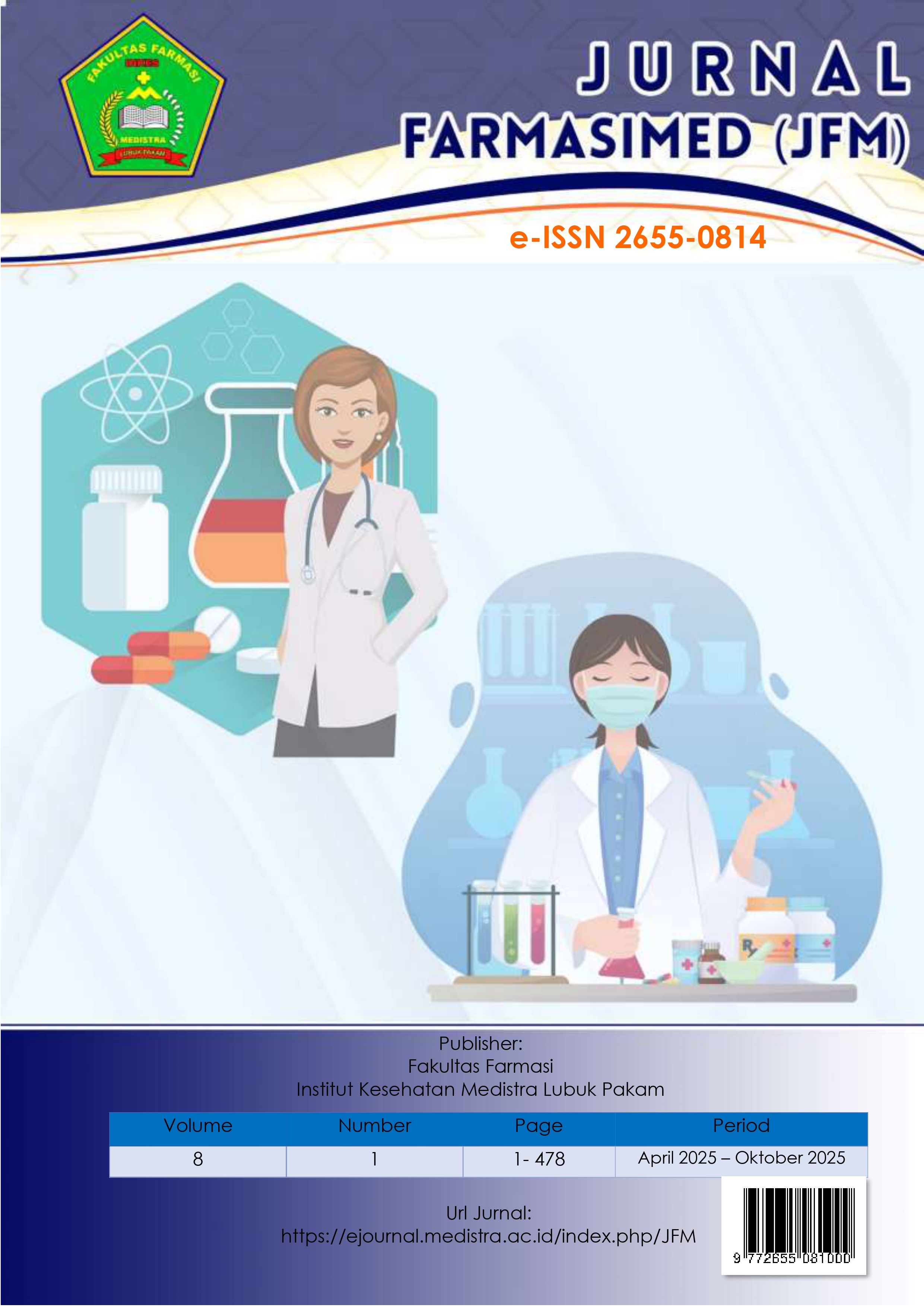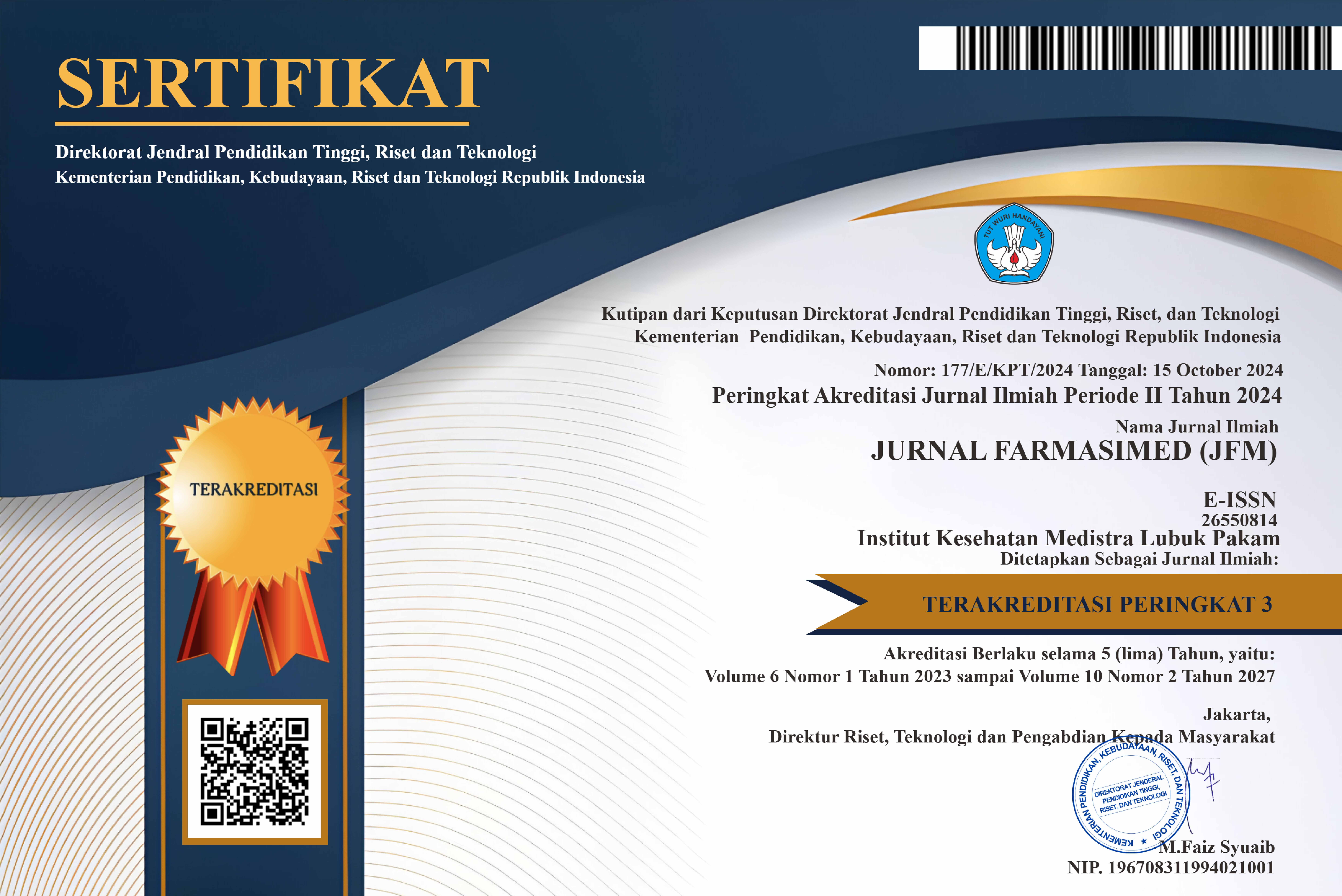From Laboratory to Algorithm: The Role of Computational Methods in New Drug Design Discovery in the Digital Era
DOI:
https://doi.org/10.35451/8f4xh746Keywords:
Komputasi, Penemuan Senyawa Obat Baru, Era Digital, HKSA, Pemodelan MolekulerAbstract
In the digital era, the integration of computational methods in drug discovery has revolutionized laboratory practices, enhancing efficiency and accuracy in drug development. This article provides a comprehensive review of the crucial role of computational technology in accelerating the discovery of new drug compounds, highlighting its impact on the effectiveness and success of pharmaceutical development. Traditional drug discovery methods often require extensive time and high costs, with relatively low success rates in clinical trials. To address these challenges, various computational approaches, such as Molecular Docking, Quantitative Structure-Activity Relationship (QSAR), and machine learning, have been widely adopted in the pharmaceutical industry. This study employs a systematic approach to explore different computational techniques and their applications in identifying potential drug candidates. Findings indicate that computational tools significantly expedite the drug development process, reduce costs, and improve the success rates of clinical trials. The conclusion emphasizes the importance of leveraging computational technology as an innovative strategy in pharmaceutical research and development, ultimately accelerating the discovery of safer and more effective therapies.
Keywords: Computation, Drug Discovery, Digital Era, QSAR, Molecular Docking.
Downloads
References
[1] Ding H, Takigawa I, Mamitsuka H, et al. Similarity-based machine learning methods for predicting drug–target interactions: A brief review. Brief Bioinform 2019;21:1–17.
[2] Gupta R, Srivastava D, Sahu M, et al. Computational drug repurposing for inflammatory disorders: Challenges and opportunities. Front Pharmacol 2020;11:1–14.
[3] Pagadala NS, Syed K, Tuszynski J. Software for molecular docking: A review. Biophys Rev 2017;9:91–102.
[4] Cherkasov A, Muratov EN, Fourches D, et al. QSAR modeling: Where have you been? Where are you going to? J Med Chem 2014;57:4977–5010.
[5] Chen H, Engkvist O, Wang Y, et al. The rise of deep learning in drug discovery. Drug Discov Today 2018;23:1241–50.
[6] Macalino SJY, Gosu V, Hong S, et al. Role of computer-aided drug design in modern drug discovery. Arch Pharm Res 2020;43:1–14.
[7] Khan MI, Khan MI, Khan MA. Computer-aided drug discovery. F1000Res 2020;4:630.
[8] Shamim S et al. Molecular Docking: An Insight from Drug Discovery to Drug Repurposing Approach. Unravelling Molecular Docking - From Theory to Practice, IntechOpen; 2024.
[9] Berdigaliyev A, Aljofan M. Recent advancements in computational drug design algorithms. MDPI 2023.
[10] Kumar A, et al. Use of molecular docking computational tools in drug discovery. ScienceDirect 2021.
[11] Zhang Y, Wang Y, Zhang Y. AI-based computational methods in early drug discovery and post-marketing surveillance. IEEE Xplore 2024. https://doi.org/10.1109/ACCESS.2024.1234567.
[12] Zhang Y et al. Updates on Drug Designing Approach Through Computational Methods. Future Sci OA 2024.
[13] Amin S, Aliansyah LA, Adlina S, et al. Pencarian Kandidat Obat Baru sebagai Inhibitor Main Protease SARS-CoV-2 dari Senyawa Aktif Tanaman Andrographis Paniculata: Studi in-Silico. PT. Literasi Nusantara Abadi Grup; 2021.
[14] Tropsha A. Best practices for QSAR model development, validation, and exploitation. Mol Inform 2019;29:476–88.
[15] Vamathevan J et al. Applications of machine learning in drug discovery and development. Nat Rev Drug Discov 2019;18:463–77. https://doi.org/10.1038/s41573-019-0024-5.
[16] Chen J, et al. Machine learning for drug discovery: A review. J Mol Graph Model 2020;100:107703. https://doi.org/10.1016/j.jmgm.2020.107703.
[17] Hernández-Lobato JM, others. Predicting molecular properties with deep learning. Nat Rev Chem 2019;3:1–15. https://doi.org/10.1038/s41570-019-0120-0.
[18] Naithani U, Guleria V. Integrative computational approaches for discovery and evaluation of lead compounds for drug design. Frontiers in Drug Discovery 2024. https://doi.org/10.3389/fddsv.2024.1362456.
[19] Goh GB, others. Deep learning for computational chemistry. Sci Rep 2017;7:1–10. https://doi.org/10.1038/s41598-017-09320-3.
[20] Prasetyo A, Mumpuni E, Rahmadhani SH, et al. Studi in silico senyawa bioaktif pada daun yakon (Smallanthus sonchifolius), kayu secang (Caesalpinia sappan L.), daun salam (Syzygium polyanthum) sebagai antidiabetes mekanisme kerja inhibitor SGLT-2. Pharmaceutical and Biomedical Sciences Journal 2024;6.
[21] Putri TZAD, Findrayani RP, Isrul M, et al. Studi molecular docking senyawa kimia dari herba putri malu (Mimosa pudica) terhadap inhibisi enzim α-glukosidase sebagai antidiabetes melitus. Jurnal Pharmacia Mandala Waluya 2024;3. https://doi.org/10.54883/jpmw.v3i4.104.
[22] Muslikh F, Pratama R, Ma’arif B, et al. Studi In Silico Senyawa Flavonoid dalam Mengambat RNA-dependent RNA polymerase (RdRp) sebagai Antivirus COVID-19. Journal of Islamic Pharmacy 2023;8:49–55. https://doi.org/10.18860/jip.v8i1.21722.
[23] Putri SRD, Bella I, Khaerunnisa S, et al. In silico analysis effect of potential antidiabetic from Dandang Gendis extract on aldose reductase, glucokinase, and GSK3β for type 2 diabetes mellitus. Current Internal Medicine Research and Practice Surabaya Journal 2023;4. https://doi.org/10.20473/cimrj.v4i1.42288.
[24] Thapa S, Biradar MS, Banerjee J, et al. In-silico approach for predicting the inhibitory effect of home remedies on severe acute respiratory syndrome coronavirus-2. Makara J Sci 2023;27:Article 5. https://doi.org/10.7454/mss.v27i3.1609.
[25] Akbar. Studi In Silico Senyawa Yang terkandung dalam tanaman daun sirih merah (Piper crocatum ruitz & pav) sebagai kandidat anti SARS-CoV-2. Jurnal Penelitian Universitas Tunas Bhakti Husada 2022;2:378–91.
[26] Purwantiningsih, Irfana L, Wiriadibrata AF. Penapisan in silico senyawa antimalaria dari bunga matahari (Helianthus annuus) terhadap target PfDHODH 2022.
[27] Salahuddin. Penambatan Molekul Senyawa Turunan Beta Asaron Sebagai Antimalaria. Proceeding of Mulawarman Pharmaceutical Conferences 2021;13:261–8. https://doi.org/10.25026/mpc.v13i1.476.
[28] Ruswanto R, Mardianingrum R, Lestari T, et al. In silico study of the active compounds in bitter melon (Momordica charantia L) as antidiabetic medication. Pharmaciana 2018;8. https://doi.org/10.12928/pharmaciana.v8i2.8993.
[29] Fadilla D, Arifian H, Rahmadani A, et al. Kajian in silico senyawa turunan klorokalkon sebagai antikanker. Proceeding of Mulawarman Pharmaceuticals Conferences 2018;7:45–50. https://doi.org/10.25026/mpc.v7i1.293.
[30] Kola I, Landis J. Can the pharmaceutical industry reduce attrition rates? Nat Rev Drug Discov 2016;5:1001–6. https://doi.org/10.1038/nrd.2016.1.
[31] Amin S, Rianty AD, Hidayat T. STUDI IN SILICO SENYAWA YANG TERKANDUNG DALAM TANAMAN ARTEMISIN (Artemisia annua L.) SEBAGAI ANTI SARS-COV2. Perjuangan Nature Pharmaceutical Conference, vol. 1, 2024, p. 1–24.
[32] Doytchinova I. Drug Design—Past, Present, Future. Molecules 2022;27. https://doi.org/10.3390/molecules27051496.
[33] al Qaraghuli MM, Qaraghuli A, Ar A. Where Traditional Drug Discovery Meets Modern Technology in the Quest for New Drugs. Ann Pharmacol Pharm 2017;2.
[34] Hairunnisa H. Sulitnya Menemukan Obat Baru di Indonesia. FarmasetikaCom (Online) 2019;4:16. https://doi.org/10.24198/farmasetika.v4i1.22517.
[35] Lin Y. Review of Modern Computer-aided Drug Design Methods. International Journal of Biology and Life Sciences 2022;1:47–50.
[36] Jia P, Pei J, Wang G, et al. The roles of computer-aided drug synthesis in drug development. Green Synthesis and Catalysis 2022;3:11–24. https://doi.org/10.1016/j.gresc.2021.11.007.
[37] Megantara S, Rusdin A, Budiman A, et al. Revolutionizing Antiviral Therapeutics: Unveiling Innovative Approaches for Enhanced Drug Efficacy. Int J Nanomedicine 2024;19:2889–915. https://doi.org/10.2147/IJN.S447721.
[38] Abdillah MN, Ilmah NR, Mahardhika AB. Penambatan Molekuler Senyawa Polifenolat terhadap Enzim Reverse Transcriptase sebagai Senyawa Antiretroviral (HIV-1). Jurnal Sains Dan Teknologi Farmasi Indonesia 2020;7:1–8.
[39] Amin S, Rosmiyati R, Aprillia AY, et al. Penambatan Senyawa Antivirus Pada Reseptor Non Structural Protein Sebagai Agen Terapeutik COVID-19. Jurnal Kesehatan Bakti Tunas Husada: Jurnal Ilmu Ilmu Keperawatan, Analis Kesehatan Dan Farmasi 2023;23:51.
[40] Wahyudi W, Sinaga H, Tanjung HY. Combination Tea of Vernonia Amygdalina Del. Leaves and Syzygium Polyanthum Leaves as Complementary Therapy for Type 2 Diabetes Mellitus. JURNAL FARMASIMED (JFM) 2024;7:15–25. https://doi.org/10.35451/jfm.v7i1.2303.
[41] Alfiraza EN, Listina O, Gautama TS. Effectiveness of Combination of Bitter Gourd (Momordica charantia L.) and Garlic (Allium sativum L.) Extract on Male White Mice (Mus musculus) as Aphrodisiac. Jurnal Farmasimed (JFM) 2022;5:31–8. https://doi.org/10.35451/jfm.v5i1.1242.
Downloads
Published
Issue
Section
License
Copyright (c) 2025 Syifa Rizkia Fajarini, Saeful Amin, Ansyirohanisa, Beni Maulana Habib, Muhammad Rahmat Darmawan

This work is licensed under a Creative Commons Attribution-NoDerivatives 4.0 International License.
Copyright in each article is the property of the Author.

























